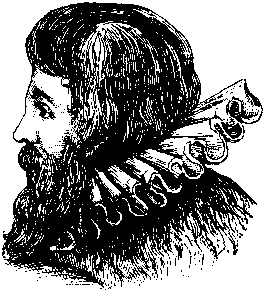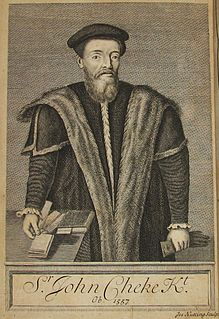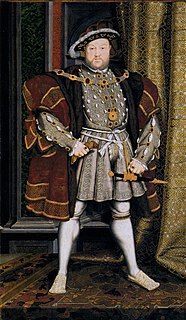Life
Born in or about 1498, Seton was educated at St John's College, Cambridge, where he graduated B.A. in 1528. Soon afterwards he was elected a fellow of St. John's, and graduated M.A. in 1532, B.D. in 1541. [1] [2]
Seton taught philosophy in his college, and gained a reputation as a tutor. [1] He belonged to the "conservative humanist" group associated to St John's, a college sharply divided by the Protestant Reformation, with others of similar views including John Christopherson and Thomas Watson. [3] He was also a good friend, however, of Roger Ascham who was one of the reformers there. [4]
After being ordained priest, Seton became one of Bishop John Fisher's chaplains, and attended him the Tower of London. In 1542 he was one of the fellows of St John's who signed an appeal to the Visitor against John Taylor, the Master. In 1544 he proceeded D.D., and about that time was appointed one of the chaplains to Stephen Gardiner, at that time bishop of Winchester and chancellor of the university, who collated him to the rectory of Hinton, Hampshire; at Gardiner's trial in 1551 Seton gave testimony in his favour. [1]
Seton was present at the disputation with Peter Martyr held at Oxford in 1550. In 1553 he was installed canon of Winchester Cathedral, and in the following year prebendary of Ulskelf in the York Minster. He was one of the doctors of divinity who, by the direction of Bishop Gardiner, went to Oxford for the disputation with Thomas Cranmer, Nicholas Ridley, and Hugh Latimer, concerning matters of religion, and on this occasion he was incorporated D.D. there on 14 April 1554. [1]
In 1555 Seton visited the Protestant John Bradford in prison, for the purpose of inducing him to recant; in 1558 he attended Thomas Benbridge on the same mission. Seton's name was on a list of Catholic clergy drawn up in 1561, described as learned but settled in papistry, and as having been ordered to remain within the City of London, or with twenty miles of it. [1]
After suffering imprisonment, Seton left England and went to Rome, where he died on 20 July 1567. [1] He is buried on the wall of the College chapel of the Venerable English College, Rome, close to the altar together with his long time friend Nicholas Morton (died after 1586). [5]

Roger Ascham was an English scholar and didactic writer, famous for his prose style, his promotion of the vernacular, and his theories of education. He acted as Princess Elizabeth's tutor in Greek and Latin between 1548 and 1550, and served in the administrations of Edward VI, Mary I, and Elizabeth I.

Sir John Cheke (Cheek) was an English classical scholar and statesman. One of the foremost teachers of his age, and the first Regius Professor of Greek at the University of Cambridge, he played a great part in the revival of Greek learning in England. He was tutor to Prince Edward, the future King Edward VI, and also sometimes to Princess Elizabeth. Of strongly Reformist sympathy in religious affairs, his public career as Provost of King's College, Cambridge, Member of Parliament and briefly as Secretary of State during King Edward's reign was brought to a close by the accession of Queen Mary in 1553. He went into voluntary exile abroad, at first under royal licence. He was captured and imprisoned in 1556, and under threat or apprehension of execution by the fire made a forced public recantation and affiliated himself to the Church of Rome. He died not long afterwards, filled with remorse for having forsworn his true belief from the infirmity of fear. His character, teaching and reputation were, however, admiringly and honourably upheld.

Thomas Wilson (1524–1581), Esquire, LL.D., was an English diplomat and judge who served as a privy councillor and Secretary of State (1577–81) to Queen Elizabeth I. He is remembered especially for his Logique (1551) and The Arte of Rhetorique (1553), which have been called "the first complete works on logic and rhetoric in English".
Robert Beaumont was Master of Trinity College Cambridge from 1561 to 1567 and twice Vice-Chancellor of the University of Cambridge. During this time, he commissioned Hans Eworth to copy the 1537 Hans Holbein portrait of King Henry VIII. This copy was bequeathed to Trinity College where it hangs to this day.
John Christopherson was Chaplain and confessor to Queen Mary I of England, Master of Trinity College, Cambridge (1553–1558), Dean of Norwich (1554–1557) and Bishop of Chichester (1557–1558) - all during the reign of Queen Mary (1553–1558).
Nicholas Metcalfe was an English churchman and college head.
Richard Curteys (c.1532?–1582) was an English churchman. A native of Lincolnshire, after his education at St. John's, Cambridge he was ordained and eventually became chaplain to Queen Elizabeth I. He was made dean of Chichester cathedral and then Bishop of Chichester. Curteys was reputedly a promoter of preaching and the clerical improvement of Anglicanism. In Curteys' episcopate, the cost of supporting many residentiaries and providing hospitality, could not be funded by the relatively small income of Chichester Cathedral. Curteys remodelled the constitution to reduce costs. Despite the changes Curteys died penniless.
Walter Haddon LL.D. (1515–1572) was an English civil lawyer, much involved in church and university affairs under Edward VI, Queen Mary, and Elizabeth I. He was a Cambridge humanist and reformer, and was highly reputed in his time as a Latinist: his controversial exchange with the Portuguese historian Jerónimo Osório attracted international attention based largely on the scholarly reputations of the protagonists.

John Young (1514–1580) was an English Catholic clergyman and academic. He was Master of Pembroke Hall, Cambridge, and was later imprisoned by Elizabeth I. He is not John Young (1534?-1605), Master of Pembroke Hall later in the century, and afterwards Bishop of Rochester.
Hugh Weston was an English churchman and academic, dean of Westminster and Dean of Windsor, and Rector of Lincoln College, Oxford.
Edward Grant was an English classical scholar, Latin poet, and headmaster of Westminster School. He was also the first biographer of Roger Ascham.
Richard Longworth was an English churchman and academic, Master of St John's College, Cambridge and Dean of Chester.
William Grindal, was an English scholar. A dear friend, pupil and protégé of Roger Ascham's at St John's College, Cambridge, he became tutor to Princess Elizabeth, the future Queen Elizabeth, and laid the foundations of her education in the Latin and Greek languages before dying prematurely of the plague in 1548.
William Malim (1533–1594) was an English academic, schoolmaster and Neo-Latin author.
Anthony Ascham, was an English astrologer.

Toxophilus is a book about longbow archery by Roger Ascham, first published in London in 1545. Dedicated to King Henry VIII, it is the first book on archery written in English.
Alban Langdale or Langdaile was an English Roman Catholic churchman and author.
John Madew was an English churchman and academic, Regius Professor of Divinity at Cambridge and Master of Clare Hall.
Robert Wingfield was an English historian.
![]()




